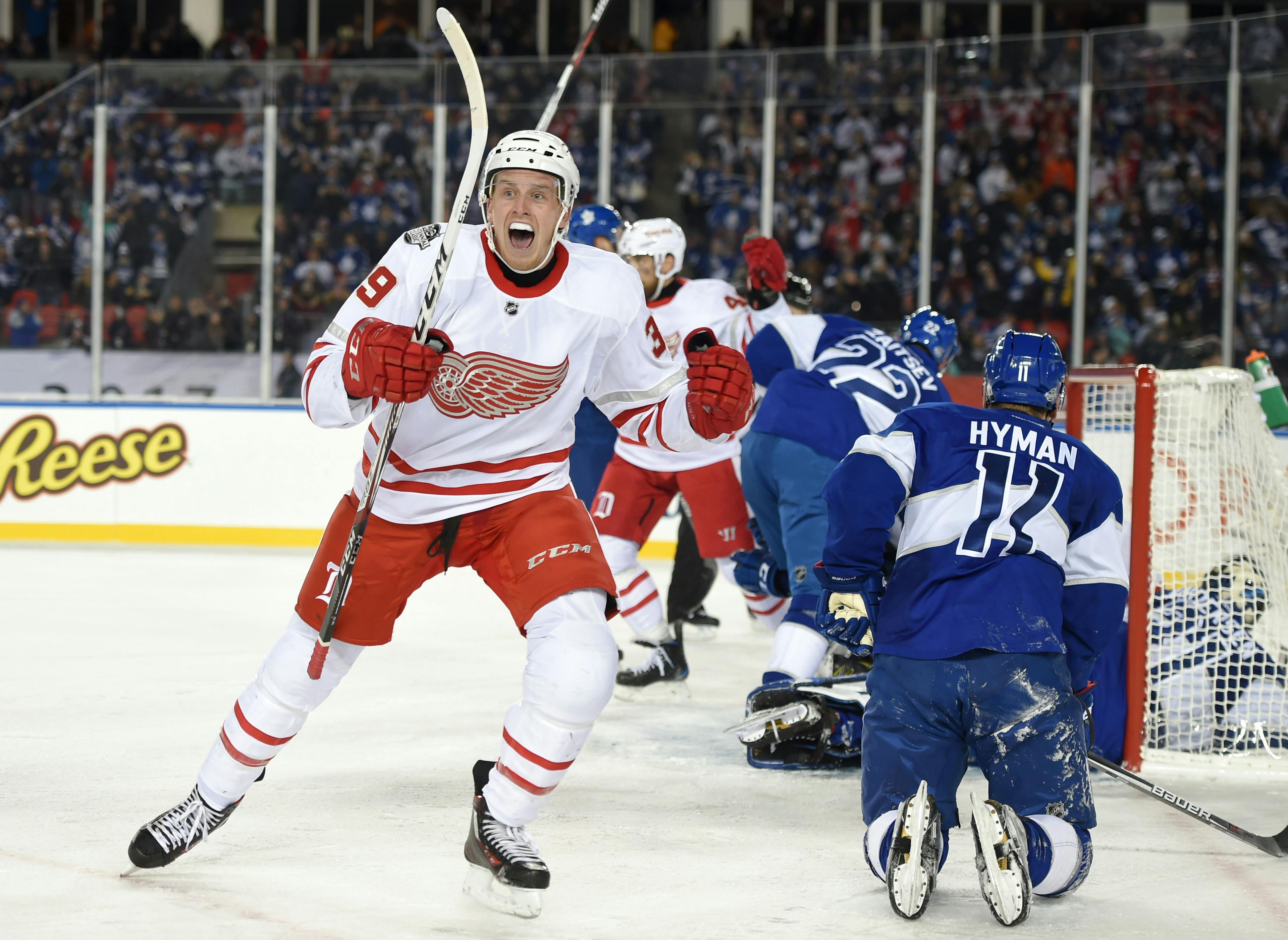Red Wings should give Larkin, Mantha and Bertuzzi line a long leash

Trusting young hockey players can be tough for head coaches in the NHL. Unless you’re lucky enough to snag one of the small handfuls of generational talents that come along every few years, skaters in their early 20s have a lot of work to do before developing into trustworthy veterans.

Figuring out how to bridge that gap in a results-based business like professional hockey is difficult; especially when a head coach’s job security generally hinges on wins and losses. There’s not a lot of incentive for Jeff Blashill to ice a roster that could be good by 2020 if it’ll cost him his job in December of 2019.
This is the battle the Detroit Red Wings have been fighting–and, for the most part, losing–since the inception of the salary cap. The organization has leaned heavily towards overpaying and overextending replacement-level bottom-six talent and dips into the free agency pool for 30-plus players with alarming regularity.
The Red Wings are slowly transitioning away from that mindset, however, and the opening months of the 2018-19 season could go a long way towards proving that they’re actually committed to going about this rebuild the correct way. With Henrik Zetterberg (sadly) out of the picture, the top line is now Dylan Larkin‘s to drive.
And it seems like Blashill has stumbled upon a potentially dangerous and exciting top unit as training camp has unfolded. Tyler Bertuzzi and Anthony Mantha have been flanking the next probable captain for Detroit, and the trio has been playing well together. Of course, looking good in training camp and looking good in February are two totally different things, but there are several reasons for Blashill to be patient with this particular line.
Even if it ends up costing Detroit a handful of games early in the season.
It seems that Blashill has a tendency to quickly pull the plug on these kinds of experiments during the campaign. According to corsica.hockey, nine different line combinations skated for at least 100 minutes together during evens last season, and none of those groups could be looked at as exciting, youth-driven lines.
There’s always an anchor of a veteran hung around the necks of the kids. Sure, Larkin and Mantha spent time on a line together last year, but they were typically asked to drag Darren Helm around. Meanwhile, Bertuzzi’s most common line combo was with Zetterberg–bad back and all–and Gustav Nyquist.
Two good players to be sure, but Bertuzzi wasn’t part of a young line digging for an identity when grouped up with Z and Goose. When Larkin, Mantha and Bertuzzi hit the ice together, it signifies a changing of the guard in Detroit. That isn’t enough reason for Blashill to keep them intact; to repeat, this is a results-based business.
It just so happens that this group could also be the top line for the Red Wings throughout the 2018-19 season. Keeping them together would also answer some important questions in Detroit.
Is Dylan Larkin a true No. 1 center? Let’s find out.
Is Anthony Mantha really a high-end driver of play at even strength, or was that simply a byproduct of playing with Zetterberg? Let’s find out.
Can Tyler Bertuzzi be a buzzsaw-type forechecker, forcing turnovers to two teammates who can finish in the blink of an eye?
Let’s. Find. Out.
Larkin shouldn’t be tasked with making Justin Abdelkader relevant again. Mantha shouldn’t be forced to skate with Frans Nielsen for 50 games this year. Instead, Blashill should allow his up-and-coming core to make some mistakes along the way, and this should be their team moving forward. (Filip Zadina is in that mix as well, but asking him to be the forechecking forward on a top line in the NHL as a rookie might be a bit much).
The good news is that the bench boss seems to know that he has a good unit on his hands. He spoke with Ansar Khan of MLive.com recently and had this to say about the promising line and what he wants to see from them moving forward:
“If you’re going to play with Larks, you don’t want to be behind him all night, so you got to play at a high pace. I also hope the three of them can become a real good O-zone line. They’ve been a good rush group, but they need to be a good O-zone group, so we can spend less time defending and more time in the opposite end. I think they have it in them, it’s just learning how to protect the puck, use cutbacks, use each other and spread the zone, so hopefully they can have good chemistry.”
It’s fair to ask the top line to protect the puck better, but guys like Zetterberg and Pavel Datsyuk–former leaders of this club–didn’t evolve into the players they became without making some mistakes and learning along the way. Hell, it took Steve Yzerman years to evolve from a high-octane offensive center into the two-way mastermind we all remember now.
That’s the kind of leash Larkin, Mantha and Bertuzzi should be given as the season opens.
There will be some growing pains to be sure, but at least there’s a light at the end of the tunnel with the line doing some heavy lifting at even strength. The same couldn’t be said for a top unit of Thomas Vanek, Larkin and Nyquist or something similar.
Mantha, Larkin and Bertuzzi play with speed and dictate the pace of play during breakouts. Once they figure out how to hang onto the puck, they could be Detroit’s reliable top unit as the rebuild unfolds.
Can they be a No. 1 line in the NHL?
Let’s find out.
Recent articles from FranklinSteele





